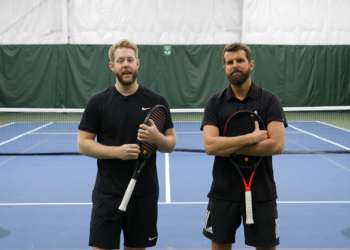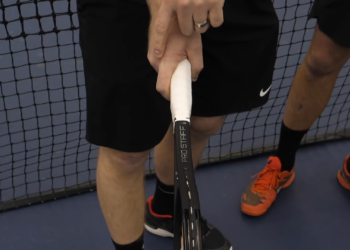Today we show you how to successfully transition to the net using “zones.” This video is for players with a PlayYourCourt rating of 59 and below.
Click here to become a PlayYourCourt Member and get your custom video coaching: https://www.playyourcourt.com/tennis-community/
Here’s a transcription below for those who like to read ????:
– [Scott] Hey guys, Scott and Nate from PlayYourCourt.com. And today we’re gonna show you how and when to come to the net based on something called a zone. Alright guys, today we’re gonna break down a concept called zones. And to be clear this video is for players with a PlayYourCourt rating of 59 and below. If you’re not in our community or familiar with our rating system. A PlayYourCourt 59 is the equivalent of a USTA 3.0. So as you can see we split the court up here into three zones. A red zone, a yellow zone and a green zone. And what these zones are gonna do is just help you understand when to come to the net. And Nate these zones work based on where the ball lands right?
– [Nate] Absolutely not, that’s actually a common misconception. Your zone is actually indicated by where you are in the court, not where the ball lands. Alright so what we’re gonna do. We’re gonna actually start today by talking about the red zone. And what do you do when you get to a red light?
– [Scott] Definitely run it, right.
– [Nate] Yeah, wait what! No, no, no, you’re not running red lights unless you want to get a ticket or whatever. But what we know we’re gonna do. When we get to a red light we’re gonna stop. And so what are we stopping? I want you to stop thinking about offense from this zone. So what you’re gonna see here is that with the red cone behind us. The tube is indicating what zone this is. And with the red zone, what I’m really gonna focus is on neutral and defensive tennis. So neutral, what does this mean? I’m gonna play a lot of balls cross court over the low part of the net. And over the longest part of the court so it’s nice and safe. The further back I go the more defensive it’s gonna be where I should be playing up four to six feet over the net. And I’m really want to stay away from the outer thirds of the court. Alright so this is the red zone and so moving in. We’re gonna be talking about the green zone. Tell us about the green zone Scott.
– [Scott] Alright so the green zone, very simple. Green means go. So just as Nate explained red when you’re pushed back behind the baseline. You’re on defense, pretty obvious. The green zone I think is even more obvious. If you get pulled so far forward that you’re almost to the service line or you’re halfway between the baseline and the service line. It’s never gonna make sense to turn around and retreat. So when you get that ball that’s shorter than the court and it pulls you in front of this yellow dotted line here into the green zone. Whether you like it or not, you’ve got no choice. You’ve got to move up to the net.
– [Nate] Alright I know what a lot of you are thinking. That we just completely glazed over the yellow zone. The space just in front of–
– [Scott] It’s obvious right, it’s a yellow light. You’re never stopping at a yellow light. It’s a go zone, it’s basically green.
– Yeah, you’re basically disobeying all traffic laws Scott. So with the yellow zone here right. Just in front of the red. Just behind the green. This is a gray area for many of us. It’s a transition zone. And this is what we’re trying to make a decision on. Are we recovering back to the red zone once we’ve hit here? Or are we preceding to the green zone as we move forward? And really what we want to keep in mind here is two things. Did I have time and am I balanced? And if I have these two components it means I can be more aggressive with my ball. I can spread the angle and perhaps I can hit it with a little bit more pace. Now from this yellow zone I certainly can move forward to the net. I just want to make sure that my opponent is out of position. And often times what we’re gonna see is our opponent really stretching for the ball. Maybe their back is exposed. This is a good indicator of when we should be going to the net. Not quite as obvious as the green zone where we almost have to go in because we’re being pulled in. This is more of a choice, we’re gamblers.
– [Scott] Kind of following normal traffic laws right. Yellow may be perceived as caution. It’s not a guarantee that I’m necessarily gonna run through this light.
– [Nate] Yep so, hence the stop light system. Like I was saying, we’re gamblers. Some of us gamble more than others with speeding tickets, traffic tickets. I don’t but with that being said. I think if you follow this system you’re gonna get a pretty good indicator of when you should be at net.
– [Scott] For sure guys and in summary. This is a pretty simple concept once we lay it out like this for you. Red means stop. If you’re pushed well behind the baseline, you’re obviously not gonna sneak to the net. Green means go if you’re yanked really far forward in the court. You’ve got to go to the net. There’s just not enough time to run back. Yellow, proceed with caution as Nate covered. There’s just gonna be a couple different situations that arise when my position is in this zone. Sometimes I’m gonna recover back to the baseline. Sometimes I’m gonna proceed to the net. So I think if you understand these zones and pay attention to where you are on the court. Again, not where the ball bounces. You’ll have a better understanding of when to come to the net. And also guys, Nate and I want nothing more than to see you improve your game. And some of these videos that we give you are great for all skill levels. But the bottom line is we don’t know a ton about you so if you click the button below. And answer a couple questions for us about your skill levels. We can send you some custom video coaching that’s more based on your skill level. So we want to help you improve, click that button below. Answer a couple questions and we’ll do the rest.
Click here to get your custom video coaching: https://www.playyourcourt.com/tennis-community/



